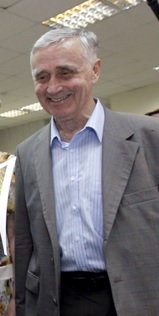Alexander Skrinsky

Alexander Nikolayevich Skrinsky (Скринский, Александр Николаевич) (born 15 January 1936) is a Russian nuclear physicist.[1]
He was born in Orenburg and was educated at the high school in the city of Gorky and then at the Lomonosov Moscow State University.
In 1957 he joined the laboratory of Gersh Budker, which was a part of the I. V. Kurchatov Institute of Atomic Energy (now the Kurchatov Institute). Since 1962, Skrinsky has been connected with the Budker Institute of Nuclear Physics, where he was director from 1977 to 2015.
Skrinsky made a significant contribution to the development of the physics of accelerators and high-energy physics (in particular, he developed a method of colliding beams, he participated in the creation of new types of colliders in electron-electron, electron-positron and proton-antiproton beams).
In 1964, together with Budker, he developed the foundations of the method of colliding beams, on the basis of which the world's first VEP-1 collider was created at the Institute of Nuclear Physics of the Siberian Branch of the Academy of Sciences of the USSR for experiments in the physics of elementary particles and a series of studies on quantum electrodynamics was carried out. In 1966 an electron-positron collider VEPP-2 was constructed, experiments on which yielded valuable results on the physics of vector mesons and other hadrons. Later, the method of colliding beams became the basis of modern high-energy experimental physics; In particular, based on the technology of the colliding beams method, the Large Hadron Collider was built.
On November 26, 1968 he was elected a corresponding member, and on December 24, 1970 a full member, of the Academy of Sciences of the USSR (since 1991 the Russian Academy of Sciences) in the Division of Nuclear Physics (High Energy Physics). He is also a full member of the American Physical Society (1999) and a foreign member of the Royal Swedish Academy of Sciences (2000).
Skrinsky was a member of CERN's (European Organization for Nuclear Research) Scientific Policy Council between 1986 and 1992.[1]
Honours and awards
[edit]- 1967: Lenin Prize - for participation in the development of the method of colliding beams
- 1989: State Prize of the USSR
- 2001,2005: State Prizes of the Russian Federation
- 1991 The V.I. Veksler Prize of the Russian Academy of Sciences
- 1997 The Demidov Prize
- 2001 The Robert R. Wilson Prize of the American Physical Society
- 2002 The Karpinsky Prize of the Alfred Töpfer Foundation, Germany
References
[edit]- ^ a b "2002 Robert R. Wilson Prize for Achievement in the Physics of Particle Accelerators Recipient". American Physical Society. Retrieved 7 April 2017.
- Article based on the equivalent article on Russian Wikipedia.
| International | |
|---|---|
| National | |
| Academics | |
Text is available under the CC BY-SA 4.0 license; additional terms may apply.
Images, videos and audio are available under their respective licenses.
